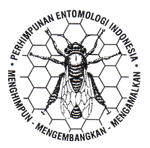The effect of DMSO on ITS2 amplification in the molecular identification of Anopheles farauti Laveran (Diptera: Culicidae), from a colony established in the laboratory
DOI:
https://doi.org/10.5994/jei.10.2.93Keywords:
molecular identification, sibling species, PCR-RFLP, rDNA ITS2, secondary structureAbstract
Sibling species identification is very important in the understanding of malaria epidemiology. Morphological criteria are usually used in the identification of anopheline species, but this fails when sibling or cryptic species occur. Analysis by PCR-RFLP of rDNA ITS2 is currently the most reliable and sensitive method for distinguishing between members of the Anopheles punctulatus group. The objective of this study was to investigate the effect of DMSO concentration on ITS2 amplification of An. farauti from the colony maintained at BATAN Jakarta using PCR-RFLP based on the rDNA ITS2. The results showed that the addition of 6 % and 7 % DMSO produced ITS2 amplification products in the size 750 bp. DMSO could be used in PCR to relieve secondary structures when amplifying high GC templates. Molecular identification of An. farauti is found to be Anopheles farauti sensu stricto.Downloads
Download data is not yet available.
Downloads
Published
2015-09-22
How to Cite
Suyono, I. J., Situmorang, J., Soesilohadi, R. H., & Pratiwi, R. (2015). The effect of DMSO on ITS2 amplification in the molecular identification of Anopheles farauti Laveran (Diptera: Culicidae), from a colony established in the laboratory. Jurnal Entomologi Indonesia, 10(2), 93. https://doi.org/10.5994/jei.10.2.93
Issue
Section
Short communications
License
Authors who publish with this journal agree to the following terms:
- Authors retain copyright and grant the journal right of first publication with the work simultaneously licensed under a Creative Commons Attribution 4.0 International License that allows others to share the work with an acknowledgement of the work's authorship and initial publication in this journal.
- Authors are able to enter into separate, additional contractual arrangements for the non-exclusive distribution of the journal's published version of the work (e.g., post it to an institutional repository or publish it in a book), with an acknowledgement of its initial publication in this journal.
- Authors are permitted and encouraged to post their work online (e.g., in institutional repositories or on their website) prior to and during the submission process, as it can lead to productive exchanges, as well as earlier and greater citation of published work (See The Effect of Open Access).








